Module 3 Body Language and Non-verbal Communication Reading and Vocabulary PPT课件(38张ppt)
文档属性
| 名称 | Module 3 Body Language and Non-verbal Communication Reading and Vocabulary PPT课件(38张ppt) | 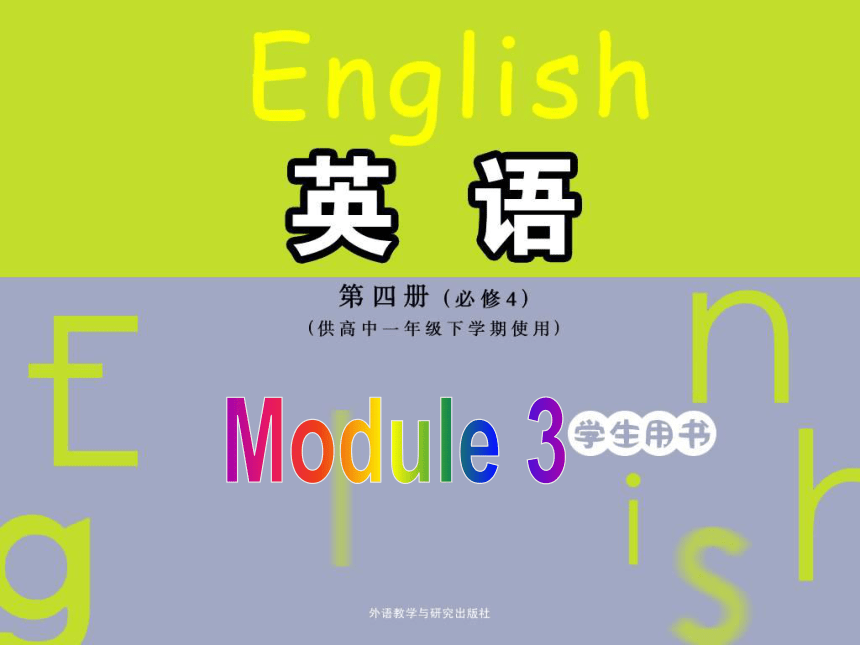 | |
| 格式 | zip | ||
| 文件大小 | 3.2MB | ||
| 资源类型 | 教案 | ||
| 版本资源 | 外研版 | ||
| 科目 | 英语 | ||
| 更新时间 | 2022-01-30 12:31:13 | ||
图片预览

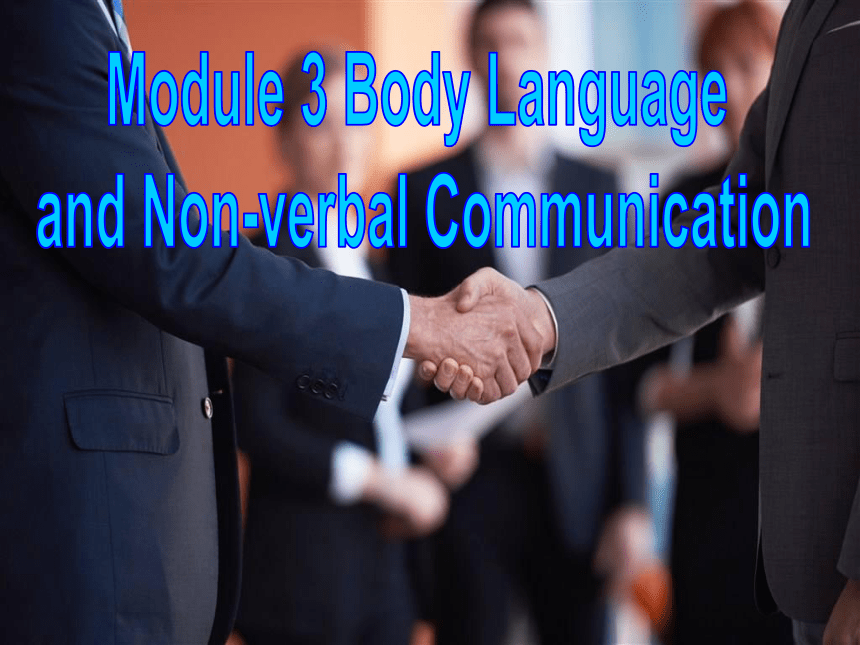

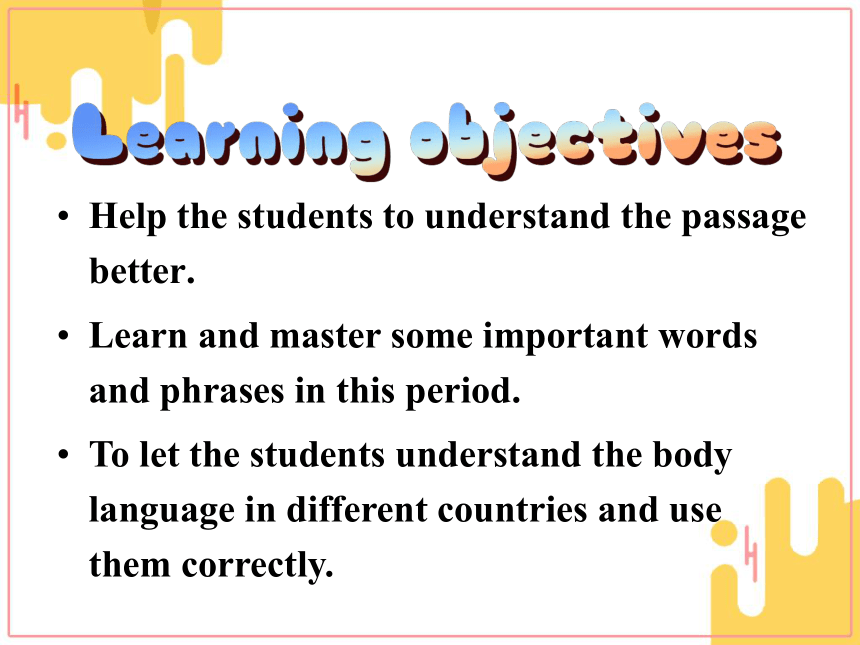
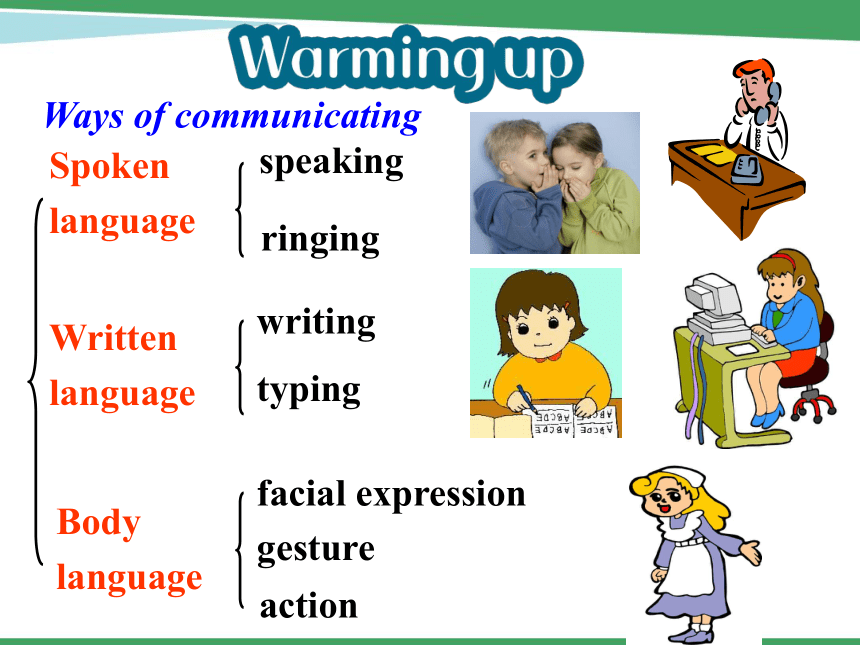
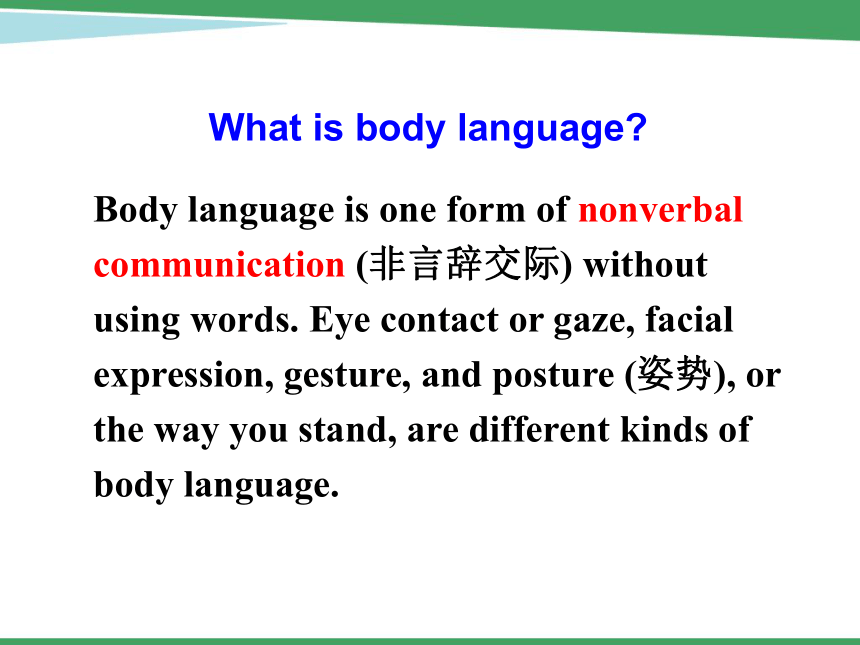
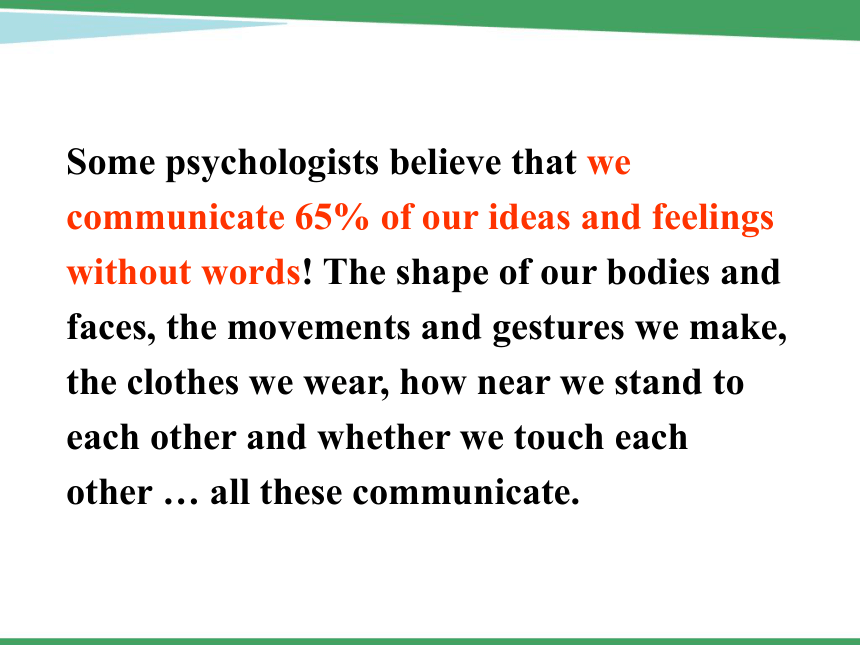
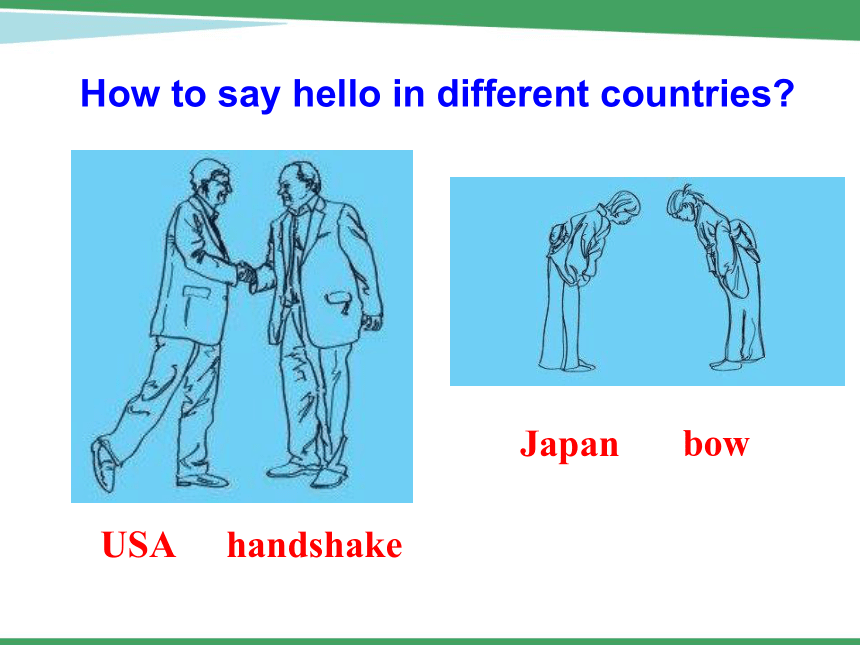

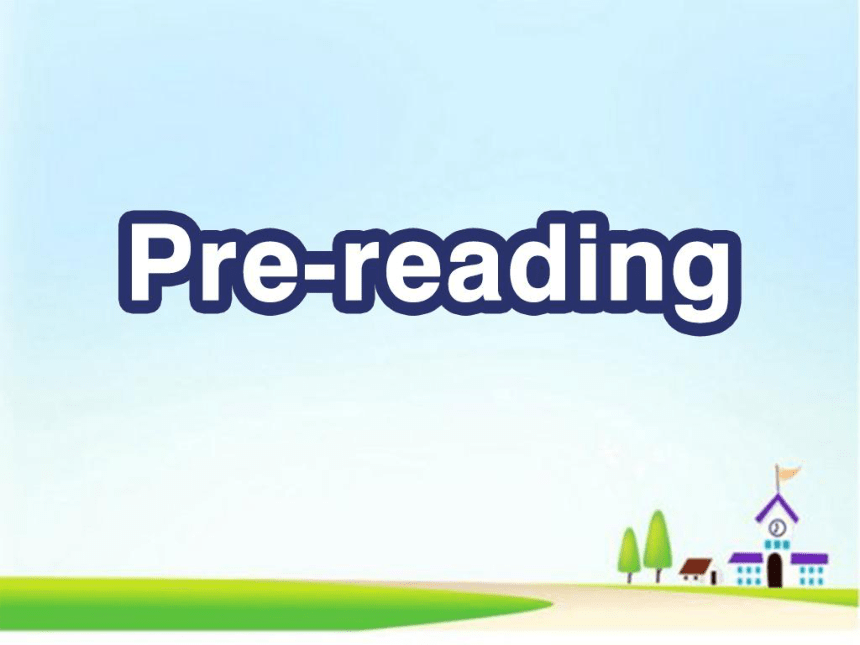

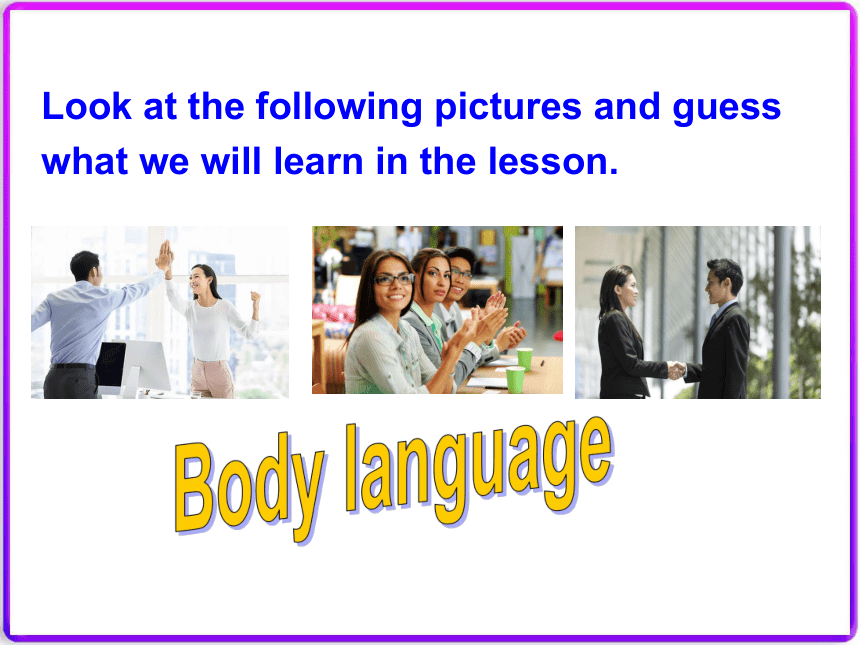
文档简介
(共38张PPT)
Module 3
Module 3 Body Language
and Non-verbal Communication
Help the students to understand the passage better.
Learn and master some important words and phrases in this period.
To let the students understand the body language in different countries and use them correctly.
speaking
ringing
writing
typing
Spoken
language
Written
language
Body
language
Ways of communicating
gesture
facial expression
action
What is body language
Body language is one form of nonverbal communication (非言辞交际) without using words. Eye contact or gaze, facial expression, gesture, and posture (姿势), or the way you stand, are different kinds of body language.
Some psychologists believe that we communicate 65% of our ideas and feelings without words! The shape of our bodies and faces, the movements and gestures we make, the clothes we wear, how near we stand to each other and whether we touch each other … all these communicate.
How to say hello in different countries
USA
Japan
handshake
bow
France
Thailand
China
kiss
join hands and bow
put the right hand over the left and bow
1. Think of some ways to greet people in China.
2. What body language do people usually use in China
3. Say some different body languages in China and western countries.
Look at the following pictures and guess what we will learn in the lesson.
Body language
The text is mainly about different body language in different countries. In order to avoid difficulties in today’s world of cultural crossroads, we had better study international customs.
What is the main idea of the passage?
1 Saying It Without Words
2 When in Rome, Do as the Romans
Do 入乡随俗
3 Greetings Around the World
4 Read My Mind
Listen and skim the text and choose the best title.
Match column A with column B.
Examples
of greetings
Para 1
Para 2
Para 3
Para 4
Para 5
A
B
greetings in Asian countries
ways of communication
fascinating body language
Body language is fascinating
for us to study.
American youth’s greeting
today
A
Europeans and Americans
2. American youths
3. Chinese
4. Muslims
5. Hindus
B
a. touching their heart,
mouth and forehead
b. shaking hands with
their right hands
c. joining their hands and
bowing their heads in
respect
d. Putting the right hand over
the left and bowing slightly
e. Greeting each other with
the expression, “Give me
five!”
Scan the text and match.
Fill in the blanks in the chart, trying to understand the key information of the text.
communication
words and 1. ___________
body
language
2. ___________ body language
“learned” body language
help to read
people's
5. ______
formal
shaking hands
3. ________
touching the heart, mouth and forehead
informal
greeting each
other with“4.
______________”
sentences
unconscious
bowing
Give me five!
minds
(1) Not all body language is conscious.
( )
(2) Europeans shake hands with their
left hand. ( )
(3) In Asia, people touch strangers when
they meet. ( )
F
F
T
Decide whether the statements are true (T) or false (F).
(4) In the US a “high five” is a way of saying hello. ( )
(5) A “high five” is a formal gesture. ( )
(6) Body language is less communicative than spoken or written language. ( )
F
T
F
what we want to express what we do
1. We agree with and trust each other. A. We put our hand above our head, waiting for the other person to slap and saying “Give me five!”
2. We show our respect to each other. B. We shake our right hands with each other.
3. We greet each other on some informal occasions. C. We put our hands together and bow our heads.
Please match “what we want to express” with “what we do”.
Fill in the blanks.
Ways of communi-cation ☆Spoken and 1. ________ words.
☆Unconscious body language and “learned” body language.
Greetings in different cultures ☆Traditionally, 2. _________ and Americans shake hands, which means they don’t have a(n) 3. _________________ and shows their trust.
written
Europeans
threatening weapon
Greetings in different cultures ☆Today American youths greet each other with the expression, “4. ___________!” One person holds up his hand, palm outwards and five fingers spread. The other person raises his hand and 5. ______ the other’s open hand above the head in a “high five”.
☆Chinese put the right hand over the left and bow slightly.
Give me five
slaps
Greetings in different cultures ☆Muslims give a “salaam”, where they touch their heart, mouth and 6. ________.
☆Hindus join their 7. _______ and bow their heads in respect.
Conclusion People give away much more by their 8. ________ than by their words.
forehead
hands
gestures
Complete the chart showing all kinds of gestures from the text.
gestures
put the right hand over the left
1. ______ slightly
give a “salaam”
—— touch their 2. ________,
mouth and forehead
4. ________ the other's open hand above the head
raise his hand
hold up the hand, 3. ______ outwards and five fingers spread
bow their heads
shake hands
join their hands
bow
heart
palm
slap
Do you think it is important to know about non-verbal communication in different cultures Why do you think that way
A. Muslims touch their heart, mouth and forehead
B. “Learned” body language is used
C. Studying body language is interesting
Below is the summary of the text with some contents missing. Choose the right content from the box to make the summary complete.
Body can be unconscious but some body language is learned. 1. ________ when meeting strangers.
B
Historically the use of hands was important to show that you were not carrying a weapon. Europeans and Americans shake hands, using the right hand because it is usually the strongest. Traditionally Chinese greet each other by putting the right hand over the left and bowing slightly. 2. ________, which is called the “salaam”.
A. Muslims touch their heart, mouth and forehead
B. “Learned” body language is used
C. Studying body language is interesting
A
Hindus join hands and bow their heads. Hands continue to be used as gestures of trust. When youths in America meet they often slap each other’s right hand above their head in a gesture called a “high five”. 3. ________ because it can often give away more about a person than words.
A. Muslims touch their heart, mouth and forehead
B. “Learned” body language is used
C. Studying body language is interesting
C
I. 根据下面各句句意以及所给单词的首字母或
汉语提示词,写出该单词的正确形式(每空
一词)。
1. Watching violence on TV makes some children
more __________ (挑衅的).
2. They were dragged from their car and
searched for __________ (武器).
aggressive
weapons
3. She made a rude ________ (姿势) at the
other driver.
4. She said Denny had received a(n)
__________ (恐吓的) letter and asked me
if I sent it.
5. Nicky’s job as a public relations director
i________ spending quite a lot of time
with other people.
gesture
threatening
involves
6. She pushed her wet hair off her ________
(前额).
7. He swept off his hat and ________ (鞠躬)
deeply to the Queen.
8. She slapped her ________ (手掌) against
the desk in anger.
forehead
bowed
palm
II. 用括号内单词的正确形式填空。
1. I haven’t had any ________________
(communicate) with him for several years.
2. She was hit on the head by a stone and
knocked ___________ (conscious).
3. “Hi” is a(n) ________ (formal) way of
greeting people.
communication
unconscious
informal
4. ___________ (traditional), the company’s
main markets have been Britain and the
US.
5. They will be ________ (slight) more
expensive but they last a lot longer.
Traditionally
slightly
1. Role play. Imagine you are Americans
and Asians respectively. Act the ways
people greet each other according to
the text.
2. Greetings vary from culture to culture.
Summarize the greetings in different
countries according to the passage.
Module 3
Module 3 Body Language
and Non-verbal Communication
Help the students to understand the passage better.
Learn and master some important words and phrases in this period.
To let the students understand the body language in different countries and use them correctly.
speaking
ringing
writing
typing
Spoken
language
Written
language
Body
language
Ways of communicating
gesture
facial expression
action
What is body language
Body language is one form of nonverbal communication (非言辞交际) without using words. Eye contact or gaze, facial expression, gesture, and posture (姿势), or the way you stand, are different kinds of body language.
Some psychologists believe that we communicate 65% of our ideas and feelings without words! The shape of our bodies and faces, the movements and gestures we make, the clothes we wear, how near we stand to each other and whether we touch each other … all these communicate.
How to say hello in different countries
USA
Japan
handshake
bow
France
Thailand
China
kiss
join hands and bow
put the right hand over the left and bow
1. Think of some ways to greet people in China.
2. What body language do people usually use in China
3. Say some different body languages in China and western countries.
Look at the following pictures and guess what we will learn in the lesson.
Body language
The text is mainly about different body language in different countries. In order to avoid difficulties in today’s world of cultural crossroads, we had better study international customs.
What is the main idea of the passage?
1 Saying It Without Words
2 When in Rome, Do as the Romans
Do 入乡随俗
3 Greetings Around the World
4 Read My Mind
Listen and skim the text and choose the best title.
Match column A with column B.
Examples
of greetings
Para 1
Para 2
Para 3
Para 4
Para 5
A
B
greetings in Asian countries
ways of communication
fascinating body language
Body language is fascinating
for us to study.
American youth’s greeting
today
A
Europeans and Americans
2. American youths
3. Chinese
4. Muslims
5. Hindus
B
a. touching their heart,
mouth and forehead
b. shaking hands with
their right hands
c. joining their hands and
bowing their heads in
respect
d. Putting the right hand over
the left and bowing slightly
e. Greeting each other with
the expression, “Give me
five!”
Scan the text and match.
Fill in the blanks in the chart, trying to understand the key information of the text.
communication
words and 1. ___________
body
language
2. ___________ body language
“learned” body language
help to read
people's
5. ______
formal
shaking hands
3. ________
touching the heart, mouth and forehead
informal
greeting each
other with“4.
______________”
sentences
unconscious
bowing
Give me five!
minds
(1) Not all body language is conscious.
( )
(2) Europeans shake hands with their
left hand. ( )
(3) In Asia, people touch strangers when
they meet. ( )
F
F
T
Decide whether the statements are true (T) or false (F).
(4) In the US a “high five” is a way of saying hello. ( )
(5) A “high five” is a formal gesture. ( )
(6) Body language is less communicative than spoken or written language. ( )
F
T
F
what we want to express what we do
1. We agree with and trust each other. A. We put our hand above our head, waiting for the other person to slap and saying “Give me five!”
2. We show our respect to each other. B. We shake our right hands with each other.
3. We greet each other on some informal occasions. C. We put our hands together and bow our heads.
Please match “what we want to express” with “what we do”.
Fill in the blanks.
Ways of communi-cation ☆Spoken and 1. ________ words.
☆Unconscious body language and “learned” body language.
Greetings in different cultures ☆Traditionally, 2. _________ and Americans shake hands, which means they don’t have a(n) 3. _________________ and shows their trust.
written
Europeans
threatening weapon
Greetings in different cultures ☆Today American youths greet each other with the expression, “4. ___________!” One person holds up his hand, palm outwards and five fingers spread. The other person raises his hand and 5. ______ the other’s open hand above the head in a “high five”.
☆Chinese put the right hand over the left and bow slightly.
Give me five
slaps
Greetings in different cultures ☆Muslims give a “salaam”, where they touch their heart, mouth and 6. ________.
☆Hindus join their 7. _______ and bow their heads in respect.
Conclusion People give away much more by their 8. ________ than by their words.
forehead
hands
gestures
Complete the chart showing all kinds of gestures from the text.
gestures
put the right hand over the left
1. ______ slightly
give a “salaam”
—— touch their 2. ________,
mouth and forehead
4. ________ the other's open hand above the head
raise his hand
hold up the hand, 3. ______ outwards and five fingers spread
bow their heads
shake hands
join their hands
bow
heart
palm
slap
Do you think it is important to know about non-verbal communication in different cultures Why do you think that way
A. Muslims touch their heart, mouth and forehead
B. “Learned” body language is used
C. Studying body language is interesting
Below is the summary of the text with some contents missing. Choose the right content from the box to make the summary complete.
Body can be unconscious but some body language is learned. 1. ________ when meeting strangers.
B
Historically the use of hands was important to show that you were not carrying a weapon. Europeans and Americans shake hands, using the right hand because it is usually the strongest. Traditionally Chinese greet each other by putting the right hand over the left and bowing slightly. 2. ________, which is called the “salaam”.
A. Muslims touch their heart, mouth and forehead
B. “Learned” body language is used
C. Studying body language is interesting
A
Hindus join hands and bow their heads. Hands continue to be used as gestures of trust. When youths in America meet they often slap each other’s right hand above their head in a gesture called a “high five”. 3. ________ because it can often give away more about a person than words.
A. Muslims touch their heart, mouth and forehead
B. “Learned” body language is used
C. Studying body language is interesting
C
I. 根据下面各句句意以及所给单词的首字母或
汉语提示词,写出该单词的正确形式(每空
一词)。
1. Watching violence on TV makes some children
more __________ (挑衅的).
2. They were dragged from their car and
searched for __________ (武器).
aggressive
weapons
3. She made a rude ________ (姿势) at the
other driver.
4. She said Denny had received a(n)
__________ (恐吓的) letter and asked me
if I sent it.
5. Nicky’s job as a public relations director
i________ spending quite a lot of time
with other people.
gesture
threatening
involves
6. She pushed her wet hair off her ________
(前额).
7. He swept off his hat and ________ (鞠躬)
deeply to the Queen.
8. She slapped her ________ (手掌) against
the desk in anger.
forehead
bowed
palm
II. 用括号内单词的正确形式填空。
1. I haven’t had any ________________
(communicate) with him for several years.
2. She was hit on the head by a stone and
knocked ___________ (conscious).
3. “Hi” is a(n) ________ (formal) way of
greeting people.
communication
unconscious
informal
4. ___________ (traditional), the company’s
main markets have been Britain and the
US.
5. They will be ________ (slight) more
expensive but they last a lot longer.
Traditionally
slightly
1. Role play. Imagine you are Americans
and Asians respectively. Act the ways
people greet each other according to
the text.
2. Greetings vary from culture to culture.
Summarize the greetings in different
countries according to the passage.
